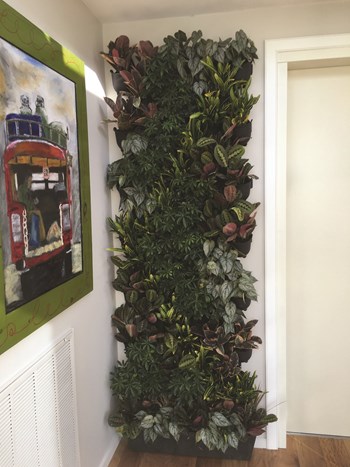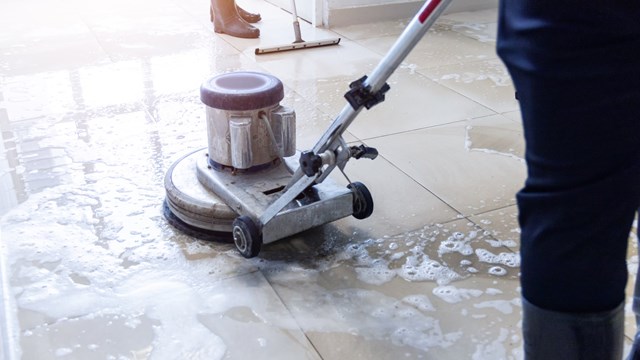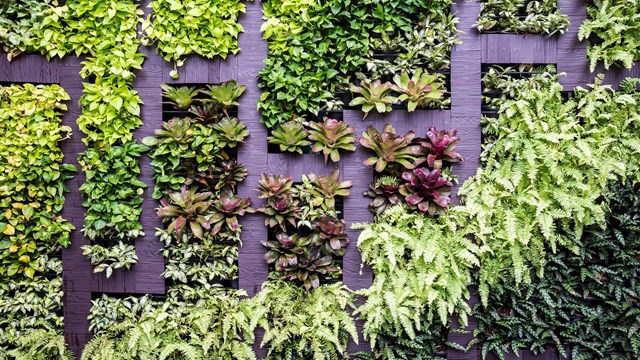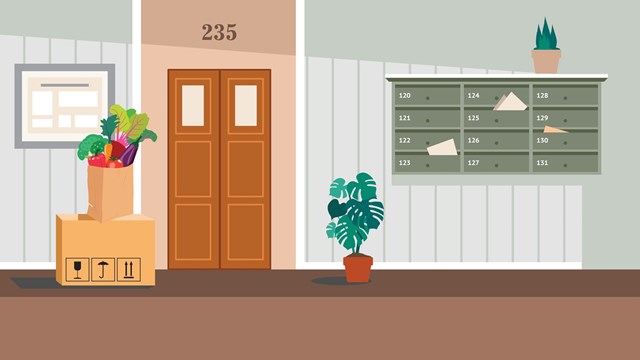
A green wall in a residential space is like having both an indoor garden and piece of art all rolled into one—and you don’t even have to travel far to a botanical garden or a museum to experience it. It’s a currently a very popular trend in landscape design in which walls are covered with plants and can be found these days in some businesses, public spaces, and homes. Not only will green walls (also known as living walls or vertical gardens) appease the conservation-minded, but they also provide an opportunity for boards and managers to think about how they could spruce up their lobby or common area. Installing a green wall in a residential building is sure to be a conversation piece between tenants and visitors, but there are definitely things to consider before embarking on such an undertaking.
The Benefits of Green Walls
Those who specialize in green walls agree that the major advantage of having them is purely environmental. “Plants help reduce things—the viruses like the common cold,” says Trevor Smith of Land Escapes Design, located in Belmont, Massachusetts, “but they also absorb harmful VOCs [volatile organic compounds], like formaldehyde and benzene that are given off by rugs, paints, furniture and appliances. All these plastics and all these man-made items around us are constantly off-gassing and releasing subtle chemicals into the air, and plants absorb those chemicals and detoxify the air around us.”
“There’s a huge interest in what plants offer, in terms of benefits for improving indoor air quality or reducing stress,” says Michael Coraggio, CEO and founding principal of EcoWalls, based in Bordentown, New Jersey. “A lot of the developers that we work with in the mixed-use arena are looking to create a certain context and space where people that are in their buildings can go and experience nature and the garden, and some of the holistic benefits that the plant material has to offer.”
It’s a sentiment that’s shared by Sean Campbell, president of Grundys Plantscaping, which serves the greater Philadelphia and New Jersey areas. “They create ambiance of well being and happiness, they help reduce stress levels for people,” he says. “They act as a sound insulator and thermal regulation...High-end residential or corporate spaces are investing in plants in more of the common areas where people can go take a break and relax.”
Setting, Pests, Costs: What to Consider Before Installation
Boards or homeowners associations who are interested in installing a green wall (which could consist of panels or trays, according to national landscaping company Ambius) in their common space should think about the structural factors involved, including whether you want the vertical garden mounted on the wall or created as a freestanding structure.
“You’re gonna want to address things like the load-bearing capacity on the wall,” says Coraggio. “You wanna make sure that whichever system you’re using, the wall can support the weight of that system plus the plant material...Just like having plants in a building or any sort of living material, there is some level of cultivation and care that will go along with any green wall.”
Smith says that any wall with studs should work as far as mounting a living garden. “There are multiple systems,” he explains, “but usually a living wall averages about between, say, 25 and 65 pounds per square foot when totally saturated. I always tell people ‘I need a wall that can hold 65 plus pounds per square foot when saturated.’”
Of course, there’s watering and lighting to consider in addition to deciding whether the site is suitable for an installation. “You’re gonna have to have a source of water for the irrigation,” says Campbell. “You’re gonna have to have a water line run to the area and a drainage line run. Just as important to that is lighting. If you don’t have the proper lighting for the wall, the plants are gonna suffer and they’re just not gonna do well.”
Like any plant environment, green walls are not immune to the problems of attracting pests such as insects. “That can definitely be mitigated,” says Smith. “The biggest pest that comes from a living wall are just the little white flies when indoor plants are kept too wet. When the plants get sick, sometimes you get things like aphids, but those things are very easily remedied. You can just put up little traps and that takes care of those. If you ever have a pest outbreak, like aphids or something on a sick wall, then you just treat that with an insecticidal soap. It’s all safe, organic and easy to do.”
According to Coraggio, the costs involved in pricing a green wall accurately depend on different variables such as “plant material, the location, or what sort of equipment is being required to install and maintain the system. For example, a very short living wall that doesn’t require any scaffolding would probably be less costly to install than something very tall...We know that our clients have a general price point to see if it fits to their expectations and where they’re at. Usually, we’re looking at anywhere from $180 [per square foot], fully installed and planted, so that’s the turnkey price point—to around $225 [per square foot], fully installed and planted for our projects.”
“I used to try to come up with a square foot price, and it’s just always different,” says Smith. “It depends on the plants and by the size of the wall. If it’s a large wall and I get a price break, I’m able to do it for cheaper, smaller walls. And the irrigation system sometimes can be a little pricey, depending on where it is and how easy it is to tap into the plumbing. For instance, I installed a 2 x 8 foot living wall, manually watered, in a person’s home. Eight feet tall, and a little over two feet wide, and that was just a little over $3,000.”
Plant Types That Do Well in a Green Wall
There are certain plants that perform well as part of a green wall, according to Smith. “The majority of indoor plants do well in a living wall,” he says, “plants like Pothos, Dracaena, and philodendron, and then you can get into the peace lilies and the spider plants.”
“Some of the basic plants that do very well are Pothos and Neon Pothos,” adds Campbell. “They give a great contrast because one’s a bright yellow and one’s a dark green. It really all depends on your lighting situation and the environment that it’s going to be in. So if it’s going to be an indoor green wall, you would have a lot of your Florida tropical plants in there, and it all depends on the lighting situation.”
From Planning to Build-Out
Installing a green wall usually begins with a consultation between the green wall specialist and the client, which can include an inspection of the site. “I’d take a look at where it is going, check out the light conditions, maybe make some suggestions,” says Smith, “because sometimes where people think it’s great isn’t always the best case. Sometimes there’s too little or too much light. We work out the perfect size [and] price in the situation. When that happens, we will come in and prep the wall and we install the whole thing, plants and all. Everything’s customizable, which is the beauty of it all.”
Speaking from his perspective, Campbell says the consultation consists of explaining the whole system to the client, finding out what they want, and discussing the budget. “If they accept [the proposal] and they want to move forward, it’s pretty simple,” he says. “We coordinate everything, we bring everything in-house. Pretty much it goes: installing the bracket system, the irrigation system, and the plants. So it’s pretty cut and dry once we get past [them]accepting the proposal process.”
In addition to getting the components (water, drainage and lighting requirements) addressed, Corragio’s team does what is called a ‘pre-grow’ prior to the actual installation. “We manufacture a modular system and our modular tiles are about 3 feet by 3 feet by 5 1/4 inches thick. We can pre-grow all those tiles at our greenhouse—pre-planting them [and] pre-acclimating all the plants. Then right before installation, we simply take apart the puzzle. We put it into a climate-controlled vehicle, and we’ll show up with a turnkey finished, fully-acclimated living wall that we’ll install after all the utilities are addressed.”
Taking Care of Your Green Wall
The companies that installed the green walls will usually drop in for the occasional maintenance visit. “They come in and trim and just diagnose the wall,” Campbell says. “A lot of it it’s being run off of timers for the irrigation, but it still needs constant upkeep. You’re doing a little bit of babysitting to make sure it’s running properly, and then constant detailing to make sure that the design’s kept in place, all the dead leaves are removed. It’s just keeping that beautiful aesthetic look.”
Coraggio’s company employs a remote monitoring system that can let them know the status of the installed living wall, such as whether it’s been watered. “We can generally monitor the control mechanisms of every component and facet of the living wall from afar,” says Coraggio. “And then we have a local maintenance technician who will work with you and address if there was ever any troubleshooting that was required. Usually once a month, we have a technician come out, they will clean the plant material, they’ll check the irrigation system, [and] go refill any fertilizer concentrate that needs to be done.”
With proper maintenance, a green wall will ultimately bring a fresh and beautified look to a building’s lobby or common area that goes a step beyond decorating it with a potted plant, a vase or a painting—while at the same time contributing to the good of the environment. A building’s own vertical garden is sure to make tenants and visitors stop and observe it.
“The great thing about a living wall is, well, it’s beautiful to look at,” says Smith. “It’s wonderful...like a rotating piece of artwork, which is great for say a common area. But they also are wonderful in urban environments because they don’t take up any floor space or they take up very little floor space. You can have 50 plants on the wall, but if you were gonna try to have 50 [floor] plants in your house, it would look like Wild Kingdom. You get all the benefits of plants without taking up a whole lot of floor space and then you get the added piece of the living artwork.”
David Chiu is an associate editor of New England Condominium.






Leave a Comment